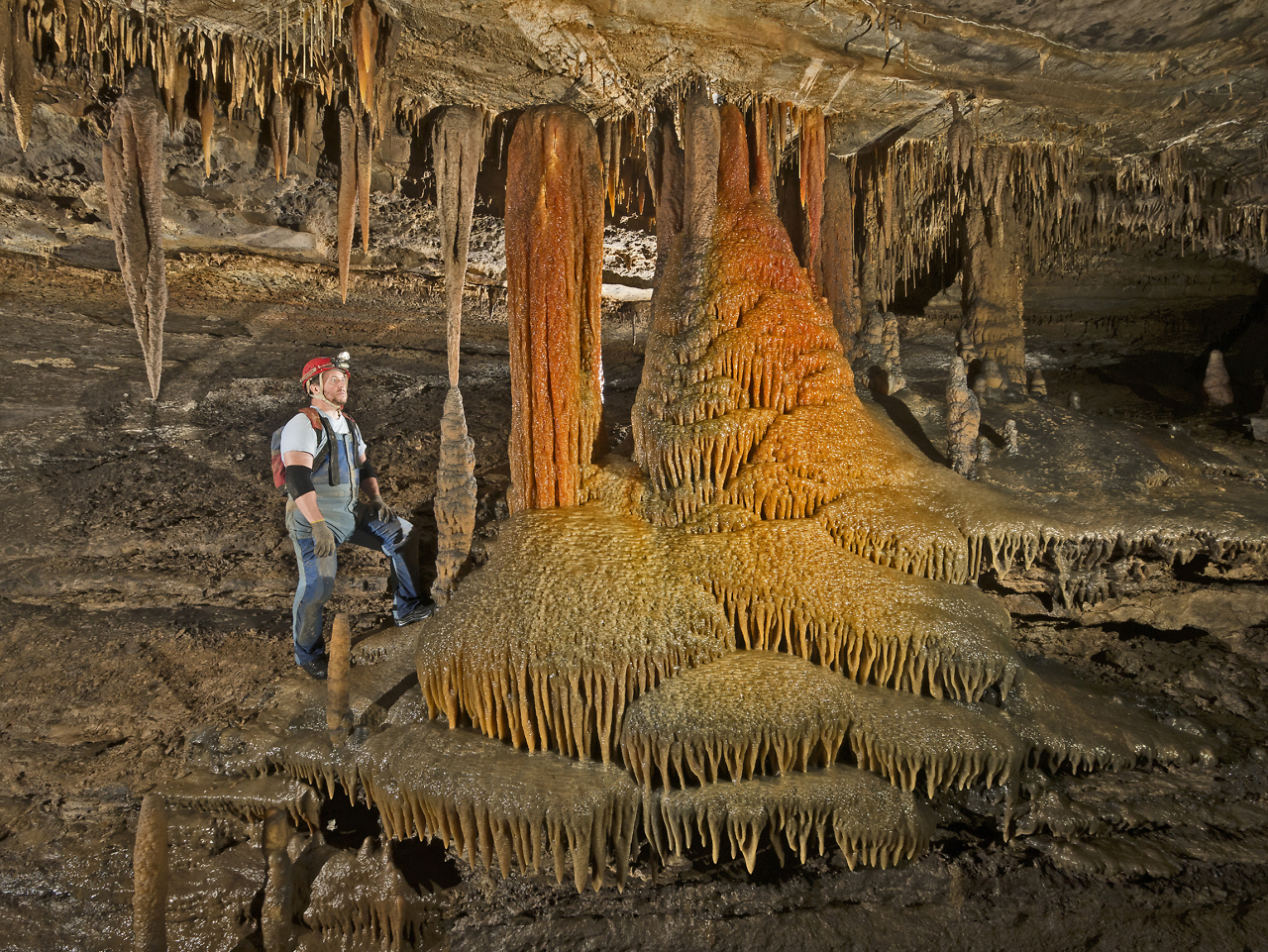Hidden Tennessee
Cave expert Larry E. Matthews takes readers on a remarkable tour of the Middle Tennessee underground
Ask the average person to think of Tennessee caves, and they will likely picture Ruby Falls (or at least its name painted on a barn roof). They may know of the Prohibition-era dance floor in Cumberland Caverns (now revived as a live music venue) or perhaps the Lost Sea. But these familiar attractions represent only a tiny fraction of the more than 10,000 caves recorded within the state by the nonprofit Tennessee Cave Survey.
 Writing about these wild caverns — many of them seen by only a handful of intrepid explorers — has been a lifelong passion for cave expert Larry E. Matthews, whose latest book, Caves of the Highland Rim, may be his best yet. The large format, 8.5-by-11.25-inch book mixes thrilling tales of discovery with lavish photographs by local cave photographer Bob Biddix. The book’s title describes the edges of a bowl-shaped depression that circles Nashville from Clarksville in the north to St. Joseph’s in the south. All of Middle Tennessee sits within this bowl in what geologists like Matthews call “the Central Basin.”
Writing about these wild caverns — many of them seen by only a handful of intrepid explorers — has been a lifelong passion for cave expert Larry E. Matthews, whose latest book, Caves of the Highland Rim, may be his best yet. The large format, 8.5-by-11.25-inch book mixes thrilling tales of discovery with lavish photographs by local cave photographer Bob Biddix. The book’s title describes the edges of a bowl-shaped depression that circles Nashville from Clarksville in the north to St. Joseph’s in the south. All of Middle Tennessee sits within this bowl in what geologists like Matthews call “the Central Basin.”
“Any direction that you go away from Nashville, you reach the rim of this basin,” Matthews writes in his introduction, adding that “the Central Basin would actually be a lake, if the Cumberland River had not cut an outlet on the Rim’s northwest edge.” A band of limestone within the elevated rim hides hundreds, if not thousands, of caves. In this, his tenth book, Matthews serves as savvy guide to 19 of the largest.
Each chapter of Caves of the Highland Rim covers a different cave system, starting with its early history and exploration, before moving on to more recent discoveries of extensions — some of them many miles long — by hard-core cavers. Often Matthews quotes directly from the logs of these explorers, giving the reader a true sense of discovery. In several caves described in the book, exploration continues today.
His background uniquely qualifies Matthews to chronicle such wonders. As a child in Nashville in the 1950s, he became fascinated by rocks, keeping shoeboxes full of them under his bed. In 1961, when he was in high school, the Tennessee Division of Geology published Caves of Tennessee by William S. Barr, a now-classic guide to 600 of the state’s wild caves. Matthews and his high school friends began driving down rural highways and gravel roads to find some of those closest to Nashville. Later he attended Vanderbilt, earning a bachelor’s and then a master’s degree in geology. In 1971 he wrote Descriptions of Tennessee Caves, adding 300 additional locations to Barr’s list. (It was also published by the Division of Geology, which has kept both books in print.) Until retiring in 2012, Matthews worked as a geologist for the Tennessee Division of Environment and Conservation, writing about the state’s caves whenever he got the chance.
The most exciting moments in the book come when Matthews lets the explorers speak in their own voices. “Starting to dig at this point was very awkward,” Nashville caver Joel Buckner says of the effort to open Haws Mill Cave in Cannon County. “You had to lie on your stomach with your head down at the hole and your torso and legs above on the slope. The air flow was so strong it would blow dirt in your face as you dug it up.”
 As Buckner’s hole grew deeper, the caver behind Buckner had to hold the digger’s feet to keep him from sliding in. But their days of work were rewarded when one of the diggers “wallered out onto a mud bank in a room about ten feet high and fifteen feet in diameter with a wall-to-wall pool of deep water.” Beyond the water lay over 7 miles of virgin passage and many large, well-decorated chambers.
As Buckner’s hole grew deeper, the caver behind Buckner had to hold the digger’s feet to keep him from sliding in. But their days of work were rewarded when one of the diggers “wallered out onto a mud bank in a room about ten feet high and fifteen feet in diameter with a wall-to-wall pool of deep water.” Beyond the water lay over 7 miles of virgin passage and many large, well-decorated chambers.
Such descriptions are accompanied by occasional maps and impressive photographs depicting pits, boreholes, mineral formations huge and tiny, saltpeter works, ancient pictographs, crawlways, water passages, biology, fossils, and maybe a hundred other things. In addition to the chapters on individual caves, later chapters cover the region’s subterranean history, biology, and geology, as well as providing information for those readers inspired to go caving. (Caving is the correct term for those in the know, who tend to deride the highfalutin spelunking.)
Claustrophobia-inducing crawlways and jaw-dropping pits will likely keep most out of these caves (even if access were not highly restricted by most caves’ private owners). Yet with a sense of exploration and wonder, not to mention superb illustrations, Matthews’ Caves of the Highland Rim makes the underground wilderness of Middle Tennessee wonderfully accessible to all.

Michael Ray Taylor’s book Hidden Nature, a mixture of memoir and subterranean natural history, will be published in August 2020. He chairs the communication and theatre arts department at Henderson State University in Arkadelphia, Arkansas.





